Beyond beautiful. When traveling to Vancouver Island, you experience a superb vista of snow-capped and pine-covered mountains alongside beautiful calm ocean waters. Not only is the scenery spectacular, but flora and fauna abound. To get there is a virtual challenge; to experience it firsthand is mind-boggling.
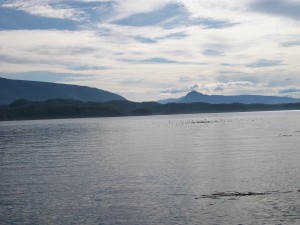
Anyone can cut a check and take a cruise ship through the Johnstone Strait, perhaps sighting a whale or two from the deck. We chose to explore the Johnstone Strait in kayaks, paying a kayak outfitter for a six day experience on the Inner Passage. The kayaking and accompanying camping on coastal beaches gave us an immersion experience we treasure.
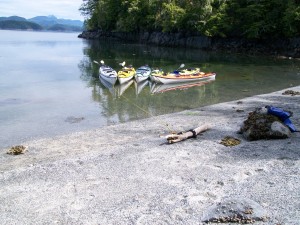
From Des Moines, you can get to Telegraph Cove, a good passage entry, a couple of ways; neither is very easy. We chose to fly from Des Moines via Denver to Vancouver, British Columbia. From there, we rented a car and drove to Tsawassen where we crossed the Georgia Strait on a British Columbia ferry, Port of Alberni. The deluxe ferry trip operates like clockwork and traverses the strait in about two hours. It was well-worth the $77 fare, we thought as we drove down its ram en route to Coastal Highway 19A. although the coastal route takes more drive time, it winds along the inner passage waters and gives one a good view of islands as well as the small towns that dot the coastline: Parksville, Qualicum Beach, Cumberland, and Courtenay. Although we could have driven further, we chose to end our day in Campbell River, at the Heron’s Landing Hotel. After a nice seafood dinner, we called it a night.
The next day’s drive to Port McNeill offers stellar scenery. Highway 19A merges with Highway 19, just north of Campbell River and offers an unforgettable vista of snow-capped mountain peaks and dense forests of majestic pines. Signs warn you to be on the look out for elk, deer, and logging trucks. It’s a couple of hours to Port McNeill, the meeting place for trip guides and kayak customers. That is one travel itinery; some travelers choose to take a sea plane from Vancouver to Port Hardy, followed by a thirty-minute taxi ride to Port McNeill. While the latter sounds easier, it is more risky, as fog may delay the plane.
At the Haida Inn, a popular hotel for locals and kayakers in Port McNeill, two young, but experienced guides, Sarah and Leah, furnished us with three dry bags and gave us instructions how to pack our gear in them. Other instructions followed; respect for sea creatures and the environment is a mus while on the Johnstone Strait.
The next morning at 7:45 a.m. sharp, Reggie, the van driver for our kayak outfitter, met us at the Haida Inn entrance. We had donned our kayak outfits: long underwear tops and bottoms made from quick-drying fabric, nylon shorts, and a quick-drying long-sleeved shirt. Some in our group of eight (two couples from Calgary and one couple from Erie Pennsylvania) already were wearing the recommended floppy hats and neoprene ocean boots. Reggie took us on a twenty-minute van ride to telegraph Cove, a historic logging town with a decent boat ramp for launching.
It didn’t matter that we were inexperienced kayakers; the guides pampered us with paddling instructions and gave us personal tips on how to load our personal and camp gear in the kayak hatches. Soon we were loaded, clad in kayak “skirts” and PFDs, and paddling out of Telegraph Cove into the wider Johnstone Strait.
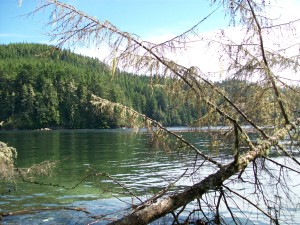
We paddled for about two hours and then stopped for lunch on a rocky beach.
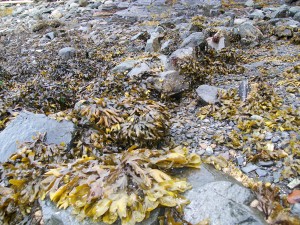
Right off the bat, we got a nature surprise; a black bear cub was playing along the shore line; it trundled off when we pulled in.
Area outfitters are known for the excellent meals they prepare for customers, and our guides kicked off the meal plan with a tasty lunch they prepared on the spot. Evening meals were restaurant-quality: Lasagna, Thai noodle with curried vegetables, fresh salmon–and the guides insisted on preparing it for us! After reloading into our kayaks, we paddled a couple of hours more to Little Kai, our campsite for nights one, four, and five of the trip. After setting up camp and eating a delicious meal, two reps from Straight Watch visited our campfire. They told us about Orca whale behavior and how important the whales are to the ecological chain. Surprisingly, a pod of Orcas swam by our campsite, interrupting their talk. We soon learned to recognize the majestic water creatures by the spews of water they expel out of their blowholes.
Trip lengths vary; customer can choose a four or six-day adventure.

Ours, a six-day, included a move to Compton island for nights two and three. And each day offers four-to-six hours of kayak travel around islands in the strait, with myriad sightings of sea mammals: sea lions, harbor seals, Dall porpoises, salmon, humpback whales, and Orca whales.

One evening on the trip, we were entertained by a pod of Orcas that swam adjacent to our Little Kai campground. On the hydrophone guides suspended in the water, we could hear a baby Orca chortle to its mother. Others in the pod surprised us by swimming to the shore and rubbing along the rocks for a relaxing back rub.
Nature enthusiasts will see a wide array of bird life both in the water and along the shores: sea gulls, bald eagles, marbeled murrelets, herons, harlequin ducks, and the quick-diving rhinocerous auklets.
Islands in the strait can brag about their great flora, too. These are no common forests; they are second growth forests with tall Sitka pine trees, Douglas fir, and alder trees. The ferns–both sword ferns and deer ferns–are deep-green and full-bodied.
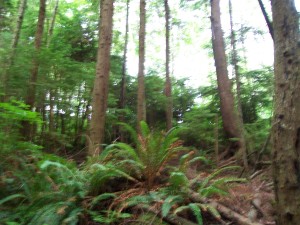
All together, the forested islands, deep waters, and Coastal Mountain vistas, provide the most spectacular scenery one can encounter!
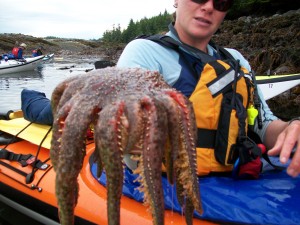
Tips:
*Kayakers should take the outfitters’ advice seriously about bringing quick-drying clothing. This designated rain forest with its cool, damp climate is unforgiving to those who come with cotton clothing.
*You should read up on the ecology of the area before venturing there. Two good books are Beyond the Whales and Listening to Whales, by Alexandra Morton, a whale researcher and resident of the strait
*Take a side trip to Vancouver, British Columbia. You will enjoy dining at the Steamworks Restaurant in Gastown as well as eating an authentic Chinese breakfast at the New Town Bakery and Restaurant in Chinatown. Vancouver is rich in visual and performing arts.